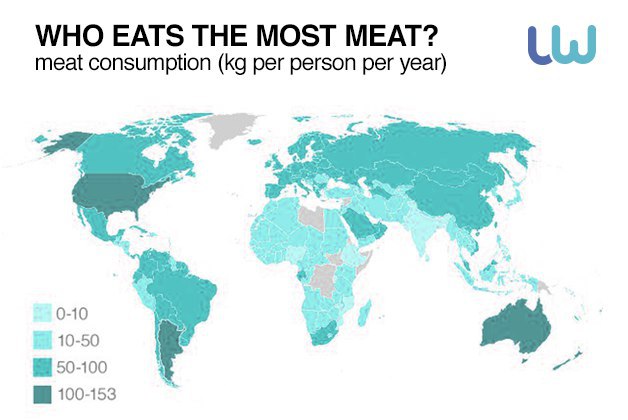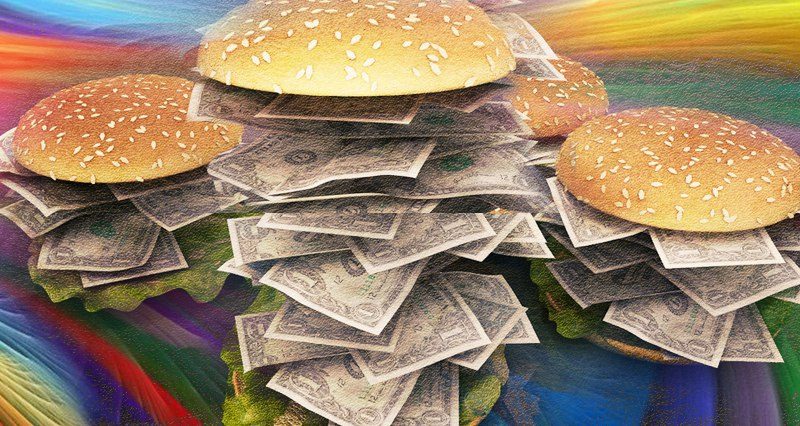In the futuristic series about post-mankind – Years and Years (1 season, 3 episode) there is a scene where the usual school lunches are replaced by self-heating burgers with artificially grown meat. As soon as you pull the valve, the content turns into a hot appetizing bun with a cutlet, indistinguishable from the original meat. The woman who demonstrates innovation is ironic: this meat is so far from the real meat that even vegans are suitable. And after a chef enjoys eating a burger grown in the laboratory and praising its flavor, she… loses her job in the dining room – for lack of need in this technological development.

But artificial meat is no longer fantasy, but reality. Although it is still prohibited to sell it, there are currently dozens of cell-based (cultured) meat companies around the world. At least ten of them are in the USA, five in Israel, two in the Netherlands, three in Canada, two in Japan, one in Singapore, two in Spain, one in France, two in Australia, and one each in China, the UK, Belgium, Russia, Argentina, Turkey, India. And this is only official – most likely, there are also clandestine developments, which are simply kept quiet. It should be taken into account that meat is not the only thing that is grown in these laboratories: sweeteners, proteins, etc. are produced there.
But what is really behind the new pseudo-meat startups? Is it really about cow care and ecology, or is it just another attempt to redefine the consumer market?
Transition point: mushroom meat and soya steaks
Against the backdrop of growing interest in vegetarianism and veganism, many businessmen in recent years have been actively engaged in the production of meat substitutes – products based on legumes with flavor additives, or blended meat (when the cutlets are mixed with various useful vegetables – such as mushrooms).
Next step: cell-based meat?
The next stage was the development of artificial meat, grown in test tubes. Cell tissue is taken from the animals and then nutrients are fed and steaks grown in special laboratories.
Unlike conventional meat, cell-based meat is produced in a controlled sterile environment, releasing a small number of satellite muscle cells from an adult animal. The physiological function of these satellite cells is to participate in muscle regeneration: they are stem cells that are able to reproduce and under the influence of certain hormones to differentiate into muscle cells.
The first lab-grown burger was unveiled at a press conference in London in 2013, and its fabrics, grown at Maastricht University in the Netherlands, are valued at US$1.2 million per pound.
Some, in connection with the first successes, predict that by the middle of this century laboratory-grown meat will have replaced 50 percent of world meat consumption, and by the end of the century intensive animal husbandry will have completely stopped and all meat will be grown in factories.
Two anti-meat trends
Meat alternatives on a vegetable (or semi-plant) basis, and then on a cell-based one, have entered the market as a result of two contradictory trends: on the one hand, the growing demand for meat and on the other hand, the ideological negation of meat.
With regard to the first trend, the fears of opponents of real meat are mainly based on pragmatic considerations. Generally speaking, the following arguments can be distinguished:
– The world population has more than doubled since the 1960s. That time there were about three billion of us, and today there are more than 7.6 billion.
– Meat production almost doubled over the same period, from 70 million tonnes to more than 330 million tonnes in 2017. Correspondingly, consumption has also increased: a part of the population has increased their income, plus the logistics of goods have been simplified. Demand especially increased in Asian countries (especially China) and Brazil, where economic growth was also observed.
– Consequently, pragmatics conclude that with such rapid population growth and demand, meat will either be undersupplied or it will lose quality at the expense of quantity.
– Cows and many other animals are ‘inefficient’ because, conditionally, to produce 15 grams of meat you need 100 grams of vegetable protein. That is, the cost of a cow is high and the meat is small.
Conclusion: We need to look for alternatives to meat.

The second trend is rather ideological, and concerns vegans, eco-friendly advocates, and animal protectors. Their arguments are fundamentally different:
– Mass meat production is a cruel process, and animals must be saved from slaughter.
– Animals (especially cows) pollute the air, and meat production is ‘dirty’. Greenhouse gases are most often cited, and animal farming is supposedly one of the leading causes of global warming.
– This is consistent with an eco-friendly ideology.
The conclusion is the same: we must look for alternatives to meat.
And both groups somehow refer to “scientific” arguments (not yet proven in practice!):
-Cultured meat will be free of bacteria, diseases, parasites, and antibiotics because the whole process is under control.
Who promotes fake meat?
As we mentioned above, only officially more than 20 companies are already involved in the process of artificial meat development. Each company uses different media resources to convince potential customers of the safety – and most importantly, the humanity – of new products. Surprisingly, 90% of publications do not mention the potential dangers of meat in test tubes – the emphasis is on economic, moral, and environmental benefits. There is a strong sense that such publications are simply paid to prepare the market for unusual products. Surveys have shown that the normal person is naturally disgusted – or at least perplexed – by such experiments.
This is what Memphis Uma Valeti’s co-founder says in an interview. However, for all the comments about distrust of the strange product, he notes that consumers “have to experience us”. That is, they don’t give any concrete answers, but they call to try and experiment with health at once.
One of the ardent fans of cell-based meat is billionaire Bill Gates – the same one who is going to reduce the global population and engage in vaccination, surveillance, and chipping.
Gates believes that new technologies will shape the future.
By the way, Gates doesn’t deny that there’s enough meat for everyone – he says there’s enough livestock to feed the world, even if the demand for meat is increasing, and the next generation of protein isn’t creating more, but improving the quality of meat. He cites lab-grown meat as improving the quality of our lives.
It is worth noting that many well-known brands are preparing for the trend, including Ikea with new meatballs, Burger King with the new version of Whopper, and others.
Another well-known promoter of fake meat is Paul Shapiro as the vice president of policy for The Humane Society of the United States. Initially, he promoted another idea – half-meat, half-plant (blended meat) – that is, to mix with vegetables, mushrooms, etc. thus enriching the steaks, but he was very enthusiastic about the idea of cultured meat.
His argument is as simple as the whaling tools he demonstrates in the video: many things that were previously unnatural and unusual, such as artificial ice, have now become an integral part of life. But people don’t eat ice, and new steaks are coming directly inside the human body.
Shapiro asserts that cultured meat is the key to feeding a world population that will reach around 9.5 billion by 2050 and, at the same time, respecting animals and preserving the environment.
Where do meat-eaters live?
Curiously, the largest number of companies engaged in unnatural meat is located in the U.S. – the leading country in the consumption of animal protein. According to data from 2018, Americans are the first to eat meat. This is largely due to the archetype of Americans – cowboy-prey cattle breeder, which protects the meat. American workers differed from their European counterparts in high-protein consumption.
Why better not to eat cell-based meat
At the moment, such meat is forbidden. A new report from the US Government Accountability Office (GAO) has given insight into how the cell-based meat industry is stuck in its R&D phase.
The GAO states: “Specific information about the technology being used, eventual commercial production methods, and composition of the final products are not yet known.
First of all, it’s extremely expensive. But this problem will be solved in time.
Secondly, note that only producers of new meat and politically engaged eco-activists almost always talk about the benefits. Hardly anyone will talk about the shortcomings of their product that is about to enter the market.
Thirdly, despite the expectations of lower costs and less environmental damage, many experts note that in the long term, the environmental impact of meat grown in the laboratory may be higher than that of livestock meat. The fact is that eco-activists have become obsessed with greenhouse emissions but have forgotten the costs of infrastructure, personnel, and expensive equipment, as well as the costs of sterilizing laboratories.
Fourthly, the same sterility provided by disposable means (most often plastic) is provided by waste – that is, additional pollution. If it is not plastic, but steel, it must be sterilized with plenty of hot water or special means – that is, this is an additional cost.
«While few studies have been done on the environmental impact of the pharmaceutical industry, the available data suggest that its carbon footprint may be 55% higher than that of the automotive industry.», MedicalXpress writes.
Even a globalist and supporter of the Malthus Gates admits that emissions from meat grown in laboratories would be only about 7% less than from beef production.
Fifth, the argument of eco-activists that the new meat will be clean and free of bacteria and medication is laughable. Yes, animals can get sick – but at least they have a strong immune system that naturally protects them from bacterial growth. If the laboratory environment is not sufficiently sterile, bacteria can reproduce in future meat without any obstacles.
«Unless the use of plastic in the production of meat by cell culture is tightly controlled, the meat could be contaminated with endocrine disruptors and other substances before it is even packaged.»
Sixth, as a continuation of the previous thesis, artificial meat is reduced to anabolic growth hormones that can have a bad effect on people who consume products. In the course of its natural development, the animal grows for several years, the hormones are formed naturally, and the risk of a hormonal failure in this consumption is much lower.
It is important to note that in Europe, the use of growth hormones in agriculture has been prohibited at all since 1981.
Seventh, it may disrupt the ecological balance. Yes, technologies destroy it themselves – but in natural conditions livestock is not just a “steak”. Animals process plants, produce natural fertilizers, produce carbon in the fields. Without accurate calculations, livestock reduction can lead to great problems.
But the eighth point is crucial here. The main problem is to cultivate a consumer attitude to life and over-consumption as such – be it meat, soybeans, or other goods and services.
The next stages are bugs and human bodies…
This is by no means the only “alternative” to meat, according to innovators. Inspired by another anti-utopia movie “Snowpiercer”, where the lower class was fed “protein bars” made of cockroaches on an ice expressway, Europe and the United States are already experimenting with the introduction of insect food on an industrial scale. Products made from insects such as chocolate bars, muesli, pasta or hamburgers are already appearing in major supermarkets across Europe.
And in the U.S. some restaurants have already started to prepare insect-based dishes. At Sushi Mazi in Oregon, visitors can choose sushi from grasshoppers along with their classic tempura and spring rolls; Oyamel in Washington, D.C., offers tacos with grasshopper sauce.
This is argued not only by the fact that by 2050 there will be a shortage of meat or maybe a crop failure, but also by the alleged usefulness – that eating some beetles helps to maintain the growth of beneficial intestinal bacteria…
As in the case of cell-based meat, legislation is already being prepared for this case – a trend the EU’s new Novel Food Regulation.
And the University of the West of England has already published a study that shows a positive perception of insect-eating in school canteens.
While some people are describing cellular meat or beetle protein, others are deciding to cannibalize. Swedish scientist Magnus Söderlund seriously argues that the problems of climate change, and argues that in the future we must “awaken the idea” of eating human flesh.
The idea of cannibalism is not new: in 2018, evolutionary biologist Richard Dawkins wondered if it would be possible to grow meat from collected human cells in a laboratory. And he justifies it as clean meat, too.
Tissue culture “clean meat” already in 2018? I’ve long been looking forward to this.https://t.co/p41NR3NEZn
What if human meat is grown? Could we overcome our taboo against cannibalism? An interesting test case for consequentialist morality versus “yuck reaction” absolutism.— Richard Dawkins (@RichardDawkins) March 3, 2018
Conclusions
Nowadays, innovations are prohibited only for technical reasons – commercial figures, methods (possibly including genetic engineering), the introduction of additional antibiotics, cell growth environment, supervision issues, etc. are not defined.
These are important comments, but they are all about technology. Almost no one asks more fundamental questions – for example, about the worldview and religion.
For example, meat consumption in India is quite high (mainly chicken), but it has not grown much in recent years – unlike leaps in Asia or Africa. This is largely due to religious practices – many types of meat (primarily beef – due to the sanctity of cows) are simply not eaten, and the posts of many branches of Hinduism also exclude meat.
Humanity becomes weak and dependent on services. Paradoxically, the more animal rights are protected (apart from meat issues, these are prohibitions on bullfighting and even on horse wagons), the more people themselves become inhuman capitalists or consumers.
The problem is much deeper than whether artificial meat is safe or not and what beetles taste like. The politicized environmental agenda is being matched by changes in food and products, in part referring to problems with the coronavirus pandemic (for example, the United States has already experienced meat shortages, and as soon as Donald Trump tried to resolve this, he was accused of cruelty to meat factory workers forced to take risks). Proponents of large innovative businesses do not talk about morality and tradition – it is important for them to break with traditional farming and reorient the market to consumption of unverified or disgusting innovations – from cell-based meat to corpses. And most importantly, they are trying to convince us that this is normal!
If to speak in an eschatological way, mankind is trying to create a paradise on a land where there is no war and the veganism of eco-friendly technology is flourishing. But the problem is that paradise is not on earth, the times of Adam and Eve are irrevocably lost, and the latest technologies with the Malthusian approach of Gates with the accompanying bio-genocide will simply not be available to poor people.
If you personally feel sorry for animals, give up meat. But replacing meat with surrogates is not only potentially dangerous (and has not been tested in practice or for generations), it also invisibly deprives us of one element after another of the human element. Conducting religious analogies is as tricky as substituting meat for soybeans or alcoholic beer for non-alcoholic – only here it is a matter of big corporations and commercial division of the market.
And the question is not so much about meat as about ourselves: what do we stand for, deprived not only of real food, but also of religion, identity, sex? Maybe it’s time to think about returning to the traditional way of life in the villages and the worldview, not about whether vegans can eat synthetic meat and how much it will cost?









Leave a Reply